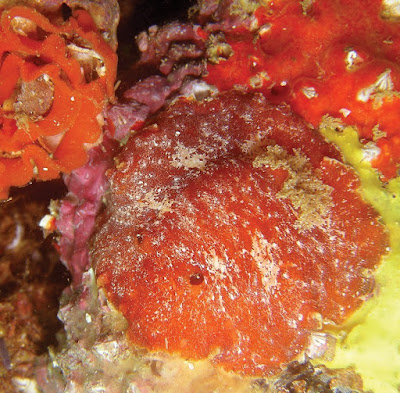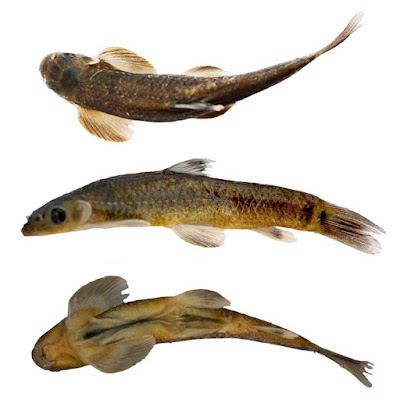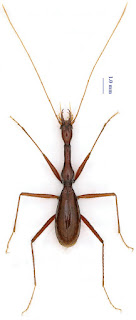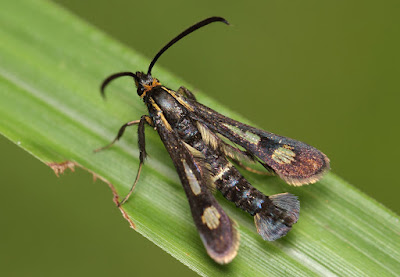[Most Recent Entries] [Calendar View]
Saturday, January 6th, 2018
| Time | Event | ||||||
| 2:06p | [Mollusca • 2018] Revision of Platydoris angustipes and Description of A New Species, Platydoris guarani, (Gastropoda: Nudibranchia) from southeastern Brazil Based on Comparative Morphology
Abstract Platydoris angustipes (Mörch, 1863) is a common nudibranch in the Western Atlantic, ranging from Florida, USA, to Rio de Janeiro, Brazil. In this study, we examined the anatomy of P. angustipes along its distribution, including its type material. Our analysis shows consistent differences between the Caribbean and Brazilian populations, mainly in the reproductive system, radular teeth and odontophore musculature. This strongly suggests that the two populations actually belong to distinct species. The Brazilian population is described herein as a new species, Platydoris guarani sp. n. Key Words: Discodorididae, Platydoris angustipes, Platydoris guarani, new species .... Family Discodorididae Bergh, 1891 Genus Platydoris Bergh, 1877 Type species: Doris argo Linnaeus, 1767, by subsequent designation (O’Donoghue 1929). • Platydoris angustipes (Mörch, 1863) ....
• Platydoris guarani sp. n. Etymology: The specific epithet is a noun in apposition, derived from the native Guarani indigenous people, some tribes of which still reside in Rio de Janeiro. Diagnosis: Body of orange color, with a white ribbon on its edge and brown spots just above the ribbon (they can be seen both dorsally and ventrally). Radula with outermost teeth not spatulate, with apex hook-shaped; cusp simple and smooth. Presence of m4a and m7b odontophore muscles. Gonad readily visible. Absence of spines on internal surface of penis and vagina. Distribution: Brazil (Valdés et al. 2006). Pernambuco: Fernando de Noronha (García et al. 2002); Alagoas: Saco da Pedra (Padula et al. 2012); Bahia: Praia de Itapoã (García et al. 2008); Rio de Janeiro: Cabo Frio: Ilha Comprida; Arraial do Cabo: Prainha (Alvim and Pimenta 2014). Habitat: Under stones, associated with sponges and ascidians (García et al. 2002), from 0 to 17 m depth. Patricia O. V. de Lima and Luiz Ricardo L. Simone. 2018. Revision of Platydoris angustipes and Description of A New Species of Platydoris (Gastropoda: Nudibranchia) from southeastern Brazil based on Comparative Morphology. Zoosystematics and Evolution. 94(1); 1-15. DOI: 10.3897/zse.94.14959 | ||||||
| 2:11p | [Ichthyology • 2017] Parapsilorhynchus swaini • A New Species of Parapsilorhynchus Hora, 1921 (Teleostei, Cyprinidae) from Mahanadi River Basin of Odisha, India
ABSTRACT A new cyprinid fish, Parapsilorhynchus swaini sp. nov., is described based on specimens collected from a stream near Harisankar, Mahanadi River basin of Odisha, India. It differs from other species of the genus in having following combination of characters: elongated and slender body (depth at dorsal fin origin 16.9-18.7% SL); narrow and slender head (width 60.0-68.7% HL, height at occiput 40.0-50.0% HL); narrow inter orbital space (46.6-50.0% HL); 33-34 lateral line scales; 3 simple pectoral fin rays, poorly developed callous pad behind lower lip which is not delimited posteriorly, pectoral fin longer than head length, presence of tubercles on snout and a black bar on the anal fin. With the description of this new species, distributional range of the genus Parapsilorhynchus is extended further north in the Eastern Ghats to the Mahanadi River drainage of Odisha. Keywords: Cyprinidae, Mahanadi River basin, New species, Odisha, Parapsilorhynchus swaini
Taxonomy Parapsilorhynchus swaini Baliarsingh & Kosygin sp. nov. Common name: Mahanadhi minnow Diagnosis: Parapsilorhynchus swaini sp. nov. can be distinguished from other species of the genus by the following combination of characters: elongated and slender body (depth at dorsal fin origin 16.9-18.7% SL); narrow and slender head (width 60.0-68.7% HL, height at occiput 40.0-50.0% HL); narrow inter orbital space (46.6-50.0% HL); 33-34 lateral line scales; 3 simple pectoral fin rays, poorly developed callous pad behind lower lip which is not delimited posteriorly, pectoral fin longer than head length, presence of tubercles on snout and a black bar on the anal fin. Distribution: Presently known from a stream near Harisankar, Mahanadi River basin in Odisha, India (Fig. 4). Etymology: Named after Dr. S. K. Swain of ICAR-Central Institute of Freshwater Aquaculture (ICAR-CIFA), Bhubaneshwar for his encouragement and support in the present study. B. K. Baliarsingh and Laishram Kosygin. 2017. A New Species of Parapsilorhynchus Hora, 1921 (Teleostei, Cyprinidae) from Mahanadi River Basin of Odisha, India. Indian J. Fish. 64(4); 44-49. DOI: 10.21077/ijf.2017.64.4.35503-06 | ||||||
| 3:31p | [Entomology • 2017] Xuedytes bellus • A Most Remarkable Cave-specialized Trechine Beetle (Coleoptera, Carabidae, Trechinae) from southern China
Abstract Xuedytes bellus Tian & Huang, gen. et sp. n. is described from a limestone cave in Du’an Karst of Guangxi, a kingdom of cavernicolous trechine beetles in southern China. From a morphological point of view, Xuedytes Tian & Huang, gen. n. seems to be the most extremely cave-adapted trechines in the world. Superficially, it looks much like Giraffaphaenops Deuve, 2002 in general body shape, in particular the structure of the prothorax, but simultaneously it is similar to Dongodytes (s. str.) Deuve, 1993, based on elytral characters, including chaetotaxy. Hence the new genus seems to represent a lineage intermediate between Giraffaphaenops and Dongodytes (s. str.). Keywords: aphaenopsian, Guangxi, ground beetle, troglobite Figure 1. Habitus of Xuedytes bellus Tian & Huang, gen. et sp. n., holotype male. Figure 2. Head (ventral) of Xuedytes bellus, a paratype female. Taxonomic treatment Xuedytes Tian & Huang, gen. n. Type species: Xuedytes bellus Tian & Huang, sp. n. Generic characteristics: Highly modified aphaenopsian trechines, body shape, in particular prothorax, similar to that in Giraffaphaenops, but elytra generally like in Dongodytes (s. str.) (Fig. 1); large-sized, with body (especially prothorax and elytra) and appendages thin and extremely elongated, eyeless and unpigmented; fore body part (head including mandibles, plus prothorax) much longer than, or as long as (excluding mandibles) elytra, respectively; body smooth; three pairs of frontal setiferous pores present on head; mandibles thin and elongated, feebly curved apically, longer than head width, right mandible edentate; labial suture completely missing; mentum bisetose on either side of tooth at base, base broadly concave; mental tooth simple, short and blunt at tip; submentum 8-setose; ligula bisetose at apex (Fig. 2); antennae very long, antennomeres 10 and 11 extending beyond elytral apices. Prothorax similar to that of Giraffaphaenops, wider than head, very strongly elongated, much longer than head including mandibles, propleura distinctly tumid in basal 1/3, visible from above; pronotum barrel-shaped, thin and distinctly elongated, lateral margins visible throughout from above, slightly narrower than head; hind latero-marginal setae absent, but two long latero-marginal setae plus two or three additional short setae present from middle to front. Elytra similar to those in Dongodytes (s. str.), narrow anteriorly and dilated posteriorly, side margins narrowly bordered throughout, shoulders lacking; striae virtually missing, only weakly traceable; two dorsal and the pre-apical setiferous pores present, each with a very long seta; chaetotaxy similar to that in Dongodytes (s. str.). Protibia smooth, without longitudinal sulcus; protarsomeres not modified in male. Ventrites VII bisetose apically in male, but quadrisetose in female. Male genitalia moderately sclerotized, small, strongly curved ventrally in lateral view, with a quite large and thin sagittal aileron; apical lobe wide and broad in dorsal view; parameres much shorter than median lobe, yet well-developed. Etymology: “Xue + dytes”. “Xue” in Chinese means “cave”, to indicate that the beetles are cavernicolous. Gender masculine. Generic range: China (Guangxi Zhuang Autonomous Region). Xuedytes bellus Tian & Huang, sp. n. Diagnosis: A large-sized, blind, cave-adapted trechine, remarkably modified morphologically, with both prothorax and elytra highly elongated and slender so that body five times longer than wide, antennae slightly shorter than body including mandibles, extending beyond elytral apices; head, pronotum and base of elytra covered with sparse erect setae. Habitus as in Figs 1 and 3. Etymology: “Bellus”, in Latin meaning “beautiful”, to refer to this beautiful aphaenopsian beetle. Distribution: China (Guangxi: Du’an). Known only from Cave II. This cave maintains a natural condition, opening on a small hill on the northern bank of the Hongshui River. The entrance is surrounded by dense bushes and not readily accessible (Fig. 5a, b). The total length of the cave is still unknown, but said to be about 200 m, according to local people. It is sufficiently wet inside the gallery and is good for cave fauna. The beetles were found running on walls and stalactites (Fig. 5c, d), sympatric with spiders (Fig. 5e, f), millipedes (Fig. 5g, h), woodlice (Fig. 5i) and crickets (Fig. 5j). Mingyi Tian, Sunbin Huang and Dianmei Wang. 2017. Discovery of A Most Remarkable Cave-specialized Trechine Beetle from southern China (Coleoptera, Carabidae, Trechinae). ZooKeys. 725: 37-47. DOI: 10.3897/zookeys.725.21040 | ||||||
| 4:47p | [Entomology • 2018] On the Taxonomy and Biology of the Clearwing Moth Chamaesphecia montis (Lepidoptera, Sesiidae)
The systematic position of Aegeria montis Leech, 1889 and Zhuosesia zhuoxiana Yang, 1977 is discussed. Having studied newly collected material, we transfer A. montis to the genus Chamaesphecia Spuler, 1910, subgenus Chamaesphecia s. str. The male of this species and its genitalia are illustrated for the first time. The host-plant of its larvae is assumed to be a species of Euphorbia (Euphorbiaceae). Zhuosesia Yang, 1977, syn. nov., is shown to be a junior subjective synonym of Chamaesphecia Spuler, 1910 with the new combination of its type species, Chamaesphecia zhuoxiana (Yang, 1977), comb. nov. Keywords: Lepidoptera, Chamaesphecia, clearwing moth, Euphorbia, host-plant, East Palaearctic, Honshu, Japan, new combination, new synonym, systematics, taxonomy, Zhuosesia zhuoxiana Naoki Yata, Arita G. Gorbunov, Yutaka Aoki and Yoshichika Naoki. 2018. On the Taxonomy and Biology of the Clearwing Moth Aegeria montis (Lepidoptera, Sesiidae). Zootaxa. 4369(3); 443–450. DOI: 10.11646/zootaxa.4369.3.9 |
| << Previous Day |
2018/01/06 [Calendar] |
Next Day >> |













